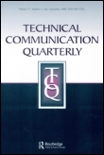
Technical Communication Quarterly
Scope & Guideline
Advancing the Art and Science of Technical Communication
Introduction
Aims and Scopes
- Social Justice and Equity in Communication:
The journal consistently addresses issues of justice, equity, diversity, and inclusion (JEDI), focusing on how these themes influence technical and professional communication practices across various contexts. - Methodological Innovations:
TCQ emphasizes innovative methodologies for research in technical communication, including qualitative, quantitative, and mixed methods approaches that engage with contemporary challenges in the field. - Interdisciplinary Perspectives:
The journal encourages interdisciplinary research, integrating insights from fields such as rhetoric, sociology, technology studies, and environmental studies to enrich the understanding of technical communication. - Focus on Emerging Technologies:
TCQ explores the implications of emerging technologies on communication practices, including digital literacy, data usability, and artificial intelligence, highlighting their impact on professional communication. - Critical Analysis of Professional Practices:
The journal provides critical analyses of professional communication practices, examining how factors such as race, gender, and socio-economic status shape communication in various professional contexts.
Trending and Emerging
- Integration of Social Justice Frameworks:
Recent publications increasingly emphasize the integration of social justice frameworks within technical communication, reflecting a growing commitment to equity and inclusion in the field. - Health Communication in Crisis Contexts:
The COVID-19 pandemic has catalyzed a surge of research focused on health communication, particularly in crisis contexts, highlighting the importance of effective communication strategies in public health. - Data Usability and Visualization:
There is a rising focus on data usability and visualization, with researchers exploring how to effectively communicate complex data to diverse audiences, which is crucial in our data-driven society. - Community-Engaged Research:
Emerging themes emphasize community-engaged research methodologies, reflecting a shift towards collaborative approaches that prioritize community voices and needs in technical communication. - Digital Literacy and Pedagogy:
The journal is increasingly addressing issues related to digital literacy and innovative pedagogical approaches in technical communication education, responding to the demands of a rapidly evolving digital landscape.
Declining or Waning
- Traditional Technical Writing:
There seems to be a waning interest in conventional technical writing practices, with fewer papers addressing standard documentation techniques and formats, as the field shifts towards more dynamic and participatory forms of communication. - Focus on Print Media:
With the rise of digital communication, topics related to print media and traditional publishing methods have become less frequent, indicating a shift towards digital and multimedia communication strategies. - Narrowly Defined Audience Studies:
Research focused on narrowly defined audience studies appears to be decreasing, as broader, more inclusive approaches to audience analysis gain traction, reflecting the need for diverse perspectives in technical communication. - Static Rhetorical Models:
There is a noticeable decline in the application of static rhetorical models, as scholars increasingly seek dynamic and context-sensitive approaches to understanding rhetoric in technical communication.
Similar Journals

Review of Communication Research
Exploring the Dynamics of Modern CommunicationReview of Communication Research is a prestigious open-access journal dedicated to advancing the field of communication studies. Published by REVIEW COMMUNICATION RESEARCH from its base in Madrid, Spain, this journal has established itself as a vital platform for scholarly discourse since its inception. With an impressive impact factor and ranked in the Q1 quartile of communication journals for 2023, it holds a commendable position, placing it within the top 13% of approximately 511 journals in the communication category on Scopus. Since becoming open-access in 2013, the journal has enabled researchers, professionals, and students to access high-quality research without financial barriers, thereby fostering a greater dissemination of knowledge and dialogue within the community. Covering a wide array of topics from communication theory to media studies, the Review of Communication Research continues to contribute significantly to the understanding and evolution of communication in today’s interconnected world. Researchers are encouraged to engage with and submit their findings to this influential journal to further enrich the scholarly landscape.

Doxa Comunicacion
Elevating voices in the study of modern communication.Doxa Comunicación is a prominent open-access journal dedicated to advancing the field of communication studies, published by Universidad San Pablo CEU, under the Faculty of Humanities and Communication Sciences. Established in 2003, this journal has gained recognition for its commitment to disseminating high-quality research and thought-provoking articles, fostering a vibrant academic community. With an ISSN of 1696-019X and an E-ISSN of 2386-3978, Doxa Comunicación occupies a vital niche in the academic landscape of Spain, contributing to both national and international discourses. In the 2023 rankings, it is categorized in the Q3 quartile within the fields of Communication and Social Sciences (miscellaneous), reflecting its competitive standing among peer publications. The journal's diverse scope, including contemporary communication theories and practices, ensures relevance for researchers, professionals, and students alike. With a Scopus rank of #333 in Social Sciences (miscellaneous) and #291 in Communication, Doxa Comunicación serves as an essential platform for innovative research that addresses the complex challenges of modern communication in a rapidly evolving society.
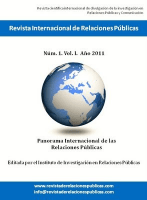
Revista Internacional de Relaciones Publicas
Fostering collaboration in the realm of public relations.Revista Internacional de Relaciones Publicas is a prominent open-access journal dedicated to advancing the field of public relations and communication research. Published by UNIV MALAGA, INST INVESTIGACION RELACIONES PUBLICAS, this journal has been pivotal since its establishment in 2011 in disseminating innovative research and insights related to public relations practices, theories, and trends globally. With the ISSN 2174-3681, the journal reaches a diverse audience, including researchers, professionals, and students, fostering a collaborative environment for knowledge exchange. Despite the absence of an HIndex or categorized quartiles, its commitment to high academic standards ensures the relevance and quality of published work. Situated in the vibrant city of Malaga, Spain, the journal encourages contributions that explore the evolving dynamics of public relations in contemporary society, making it an essential resource for anyone interested in the nuances of communication strategies and their impacts.

Revista de Comunicacion-Peru
Illuminating Contemporary Issues in Communication.Revista de Comunicación-Perú is a distinguished open-access journal published by Universidad de Piura, with a dedicated focus on communication studies. Since its inception in 2002, the journal has provided a vital platform for researchers, professionals, and students to disseminate knowledge and foster discourse in the field of communication. As of 2023, it proudly holds a Q1 classification in the Communication category and ranks impressively in Scopus, placing at #117 out of 1304 in Cultural Studies and #160 out of 511 in Communication, demonstrating its significant impact within the academic community. The journal’s scope encompasses diverse topics related to communication, cultural discourse, and media analysis, making it an essential resource for those seeking to explore contemporary issues in these areas. With a commitment to promoting scholarly exchange, Revista de Comunicación-Perú continues to play a pivotal role in shaping the communication landscape in Peru and beyond.
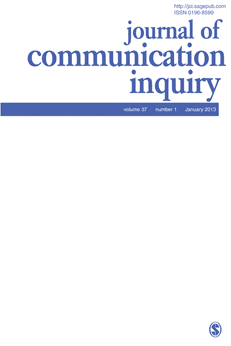
Journal of Communication Inquiry
Fostering Innovative Research in Communication and Cultural InquiryJournal of Communication Inquiry, published by SAGE PUBLICATIONS INC, is a premier interdisciplinary journal that serves as a vital platform for scholars and practitioners in the fields of communication, cultural studies, and the arts and humanities. With a rich history dating back to its inception in 1974, the journal has consistently upheld rigorous academic standards, reflected in its impressive rankings within the Q1 and Q2 quartiles across various disciplines according to the latest metrics. The journal's comprehensive scope encompasses theoretical and empirical research, catering to a diverse readership who are keen to explore contemporary communication issues and cultural dynamics. While the impact factor is not explicitly stated, the journal's Scopus ranks position it favorably within its categories, with notable percentiles that highlight its influence in the academic community. As an essential resource for researchers, professionals, and students alike, the Journal of Communication Inquiry invites contributions that advance the discourse surrounding communication practices and cultural phenomena, contributing to the ongoing dialogue in these evolving fields.
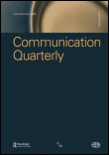
COMMUNICATION QUARTERLY
Cultivating Knowledge in the Art of CommunicationCOMMUNICATION QUARTERLY, published by Routledge Journals, Taylor & Francis Ltd, serves as a vital resource in the field of communication studies. With an ISSN of 0146-3373 and an E-ISSN of 1746-4102, this esteemed journal has been contributing to the academic discourse since its inception in 1976 and is projected to continue until 2024. Ranked Q2 in the 2023 category of Communication, it holds a respectable position in the social sciences with Scopus ranking #180 out of 511, placing it in the 64th percentile. Although it is not an Open Access journal, COMMUNICATION QUARTERLY offers a wealth of peer-reviewed articles that delve deep into nuanced theories, empirical studies, and critical analyses relevant to contemporary communication challenges. Targeted towards researchers, professionals, and students alike, this journal is essential for anyone seeking to enhance their understanding and engagement with significant issues in the communication field.
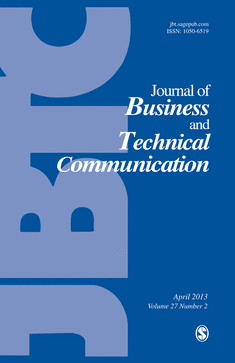
JOURNAL OF BUSINESS AND TECHNICAL COMMUNICATION
Connecting Ideas, Bridging TechnologiesJOURNAL OF BUSINESS AND TECHNICAL COMMUNICATION is a premier peer-reviewed journal published by SAGE PUBLICATIONS INC, renowned for its rigorous approach to exploring the intersection of communication practices within the realms of business and technology. Established in 1987, this journal stands at the forefront of its field with an impressive impact factor, consistently ranked in the Q1 quartile across multiple categories including Business and International Management, Communication, as well as Business, Management and Accounting. With an emphasis on innovative research and practical applications, it serves as an invaluable resource for researchers, professionals, and students aiming to enhance their understanding of effective communication strategies in a rapidly evolving business landscape. The journal does not currently offer open access, ensuring a curated and high-quality readership. Located in Thousand Oaks, California, the JOURNAL OF BUSINESS AND TECHNICAL COMMUNICATION continues to shape scholarly discourse and influence best practices in global communication.
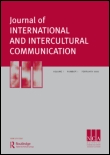
Journal of International and Intercultural Communication
Illuminating Intercultural ConnectionsThe Journal of International and Intercultural Communication, published by Routledge Journals, Taylor & Francis Ltd, is a pivotal resource in the fields of communication and cultural studies. With an ISSN of 1751-3057 and an E-ISSN of 1751-3065, this journal is recognized for its high impact, currently holding a Q2 ranking in Communication and a Q1 ranking in Cultural Studies as of 2023. This positioning underscores its significance, as it ranks 67 out of 1304 in Cultural Studies and 101 out of 511 in Communication according to Scopus, demonstrating its authoritative voice in the scientific community. Spanning converged years from 2008 to 2024, the journal features rigorous peer-reviewed articles that illuminate the complexities of intercultural interactions in an increasingly globalized world. Though it does not currently offer an open access model, its insights are indispensable for researchers, professionals, and students seeking to navigate and understand the nuances of international communication.

Jurnal Komunikasi-Malaysian Journal of Communication
Navigating the Evolving Landscape of CommunicationJurnal Komunikasi-Malaysian Journal of Communication is a premier, peer-reviewed journal published by the NATIONAL UNIVERSITY OF MALAYSIA, FACULTY OF SOCIAL SCIENCES & HUMANITIES. With an ISSN of 2289-151X and an E-ISSN of 2289-1528, this journal focuses on diverse aspects of communication theory and practice, particularly within the Malaysian context. As a significant contributor to the field, it has established itself with a respectable impact factor and currently holds a Q3 ranking in the Communication category per the 2023 Scopus Quartiles. The journal is dedicated to fostering scholarly discourse and advancing knowledge in communication studies, encompassing an array of topics from interpersonal communication to mass media impact. Since its inception, it has been committed to maintaining high academic standards while providing an engaging platform for researchers, professionals, and students. With converged years from 2014 to 2024, Jurnal Komunikasi continues to address emerging trends and challenges in communication, making it an invaluable resource for those seeking to deepen their understanding and engagement with the discipline.

Communitas
Exploring the Dynamics of Language and CommunicationCommunitas, published by the University of the Free State, is an esteemed open-access journal that has been a gateway for innovative research and discourse in the fields of communication, linguistics, and language since its inception in 2017. With an ISSN of 1023-0556 and E-ISSN of 2415-0525, the journal aims to foster scholarly exchange by providing a platform for critical analysis and interdisciplinary collaboration. Although it currently falls into Q4 in Communication and Q3 in Linguistics and Language, *Communitas* has made significant strides in establishing its presence in Scopus rankings—ranking 567 out of 1088 in Arts and Humanities and 397 out of 511 in Communication—and sources for researchers at varying stages of their careers. Addressed to a global readership, the journal invites contributions that enhance understanding and generate new perspectives on socio-linguistic issues and communicative practices, making it a pivotal resource for researchers, academics, and students committed to advancing knowledge in these dynamic fields.